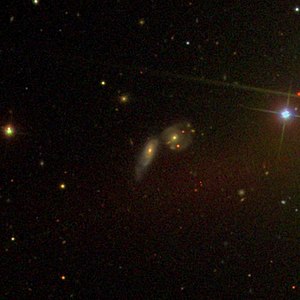IC 938
| Galaxy IC 938 |
|
|---|---|

|
|
| IC 938 & IC 937 | |
| AladinLite | |
| Constellation | Big Bear |
|
Position equinox : J2000.0 , epoch : J2000.0 |
|
| Right ascension | 13 h 44 m 31.2 s |
| declination | + 55 ° 37 ′ 39 ″ |
| Appearance | |
| Morphological type | S. |
| Brightness (visual) | 15.2 mag |
| Brightness (B-band) | 16.0 mag |
| Angular expansion | 0.4 ′ × 0.2 ′ |
| Position angle | 160 ° |
| Surface brightness | 12.3 mag / arcmin² |
| Physical data | |
| Redshift | 0.069325 ± 0.000182 |
| Radial velocity | 20783 ± 55 km / s |
|
Stroke distance v rad / H 0 |
(934 ± 66) · 10 6 Lj (286.3 ± 20.1) Mpc |
| history | |
| discovery | Edward E. Barnard |
| Discovery date | June 1892 |
| Catalog names | |
| IC 938 • 2MASX J13443120 + 5537382 • 2MASS J13443122 + 5537385 • ASK 300897.0 | |
IC 938 is a spiral galaxy of Hubble type S in the constellation Ursa Major at the northern sky . It is an estimated 934 million light years from the Milky Way and about 110,000 light years in diameter . Together with IC 937 , it forms an interacting pair of galaxies.
The galaxies IC 928 , IC 930 , IC 931 , IC 934 are located in the same area of the sky .
The object was discovered by Edward Emerson Barnard in June 1892 .
See also
Web links
Individual evidence
Attention: The sorting key “IC 0938” overwrites the previously used key “IC0938”.
